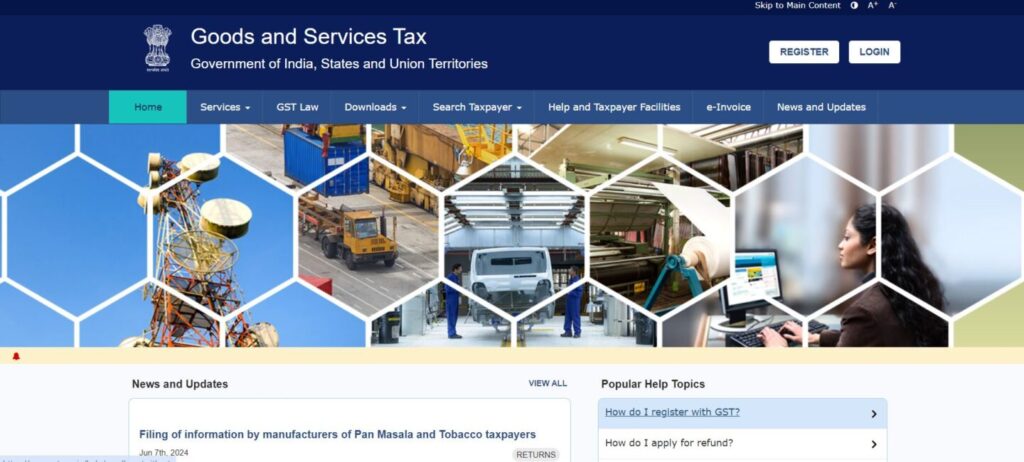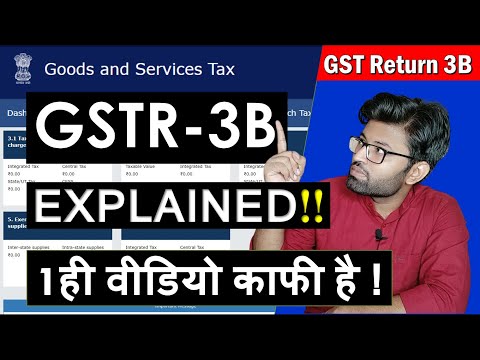Key Takeaway
- GSTR-3B is a mandatory monthly return for GST taxpayers to declare their tax liabilities, outward supplies, and input tax credit.
- Accurate and timely filing of GSTR-3B ensures compliance with GST regulations and helps avoid penalties.
- The GST portal provides a straightforward process for submitting, tracking, and downloading the GSTR-3B report.
- Key data required for GSTR-3B includes outward supplies, input tax credit, tax liability, and reconciliation with previous periods’ returns.
- Errors in GSTR-3B can be corrected in subsequent returns or using Forms GSTR-1, ensuring accurate reporting for future periods.
What is GSTR-3B Return and Who Needs to File It?
GSTR-3B is a simplified monthly return form introduced under the Goods and Services Tax (GST) regime. It is designed to capture the summary of a taxpayer’s monthly activities, including outward supplies, input tax credit (ITC), and tax liabilities. This form must be filed by all regular taxpayers, including those making inter-state supplies. Taxable persons under GST must file this return to declare their tax liability and ITC for each tax period.
GSTR-3B is crucial for ensuring compliance with GST laws and maintaining a seamless tax payment process. It includes relevant sections that detail outward supplies and eligible input tax credit. Businesses must file this return even if there are no transactions for the month, resulting in a ‘Nil Return’. Additionally, businesses under the composition scheme, known as composition taxable persons, do not need to file GSTR-3B.
Filing GSTR-3B helps in the reconciliation of tax liability and ITC claims, ensuring that businesses accurately report their taxable supplies. It is essential for businesses to understand the importance of this return and the necessity of filing it on a monthly basis to avoid penalties and ensure smooth business operations.
Submitting the GSTR-3B Report on Portal

Submitting the GSTR-3B report on the GST portal involves a series of steps designed to capture all relevant details accurately. The process begins with logging into the GST portal using the taxpayer’s credentials. Once logged in, navigate to the GSTR-3B Dashboard, where you can access the online form for the current tax period.
- Access the Dashboard:
- Log in to the GST portal and select the ‘Services’ tab. Click on ‘Returns’ and then ‘Returns Dashboard’.
- Choose the tax period for which you want to file the return and select ‘GSTR-3B’.
- Enter Relevant Details:
- Fill in the details of outward supplies and inward supplies liable to reverse charge. Ensure that all taxable supplies are reported accurately.
- Enter the details of eligible input tax credit, including the ITC available and the ITC reversed, if any.
- Calculate Tax Liability:
- Calculate the tax payable based on the details entered. Ensure that you account for both inter-state supplies and intra-state supplies.
- Use the available ITC to offset the tax liability and determine the net tax payable.
- Payment of Taxes:
- Make the GST payment using the online payment options available on the portal. This can be done through various payment options such as net banking, credit/debit cards, or through cash balances in the electronic cash ledger.
- Enter the payment details and ensure that the GST payment is made for the full amount of the tax liability.
- Submit the Return:
- After ensuring that all details are correctly entered and the payment is made, submit the GSTR-3B return.
- Download the acknowledgment receipt and the GSTR-3B PDF for your records.
Post-Submission: Tracking the Status of Your GSTR-3B Report

After submitting the GSTR-3B report, it is crucial to track the status of your return to ensure that it has been successfully filed and processed. The GST portal provides an easy way to check the return status.
- Access the GSTR-3B Dashboard:
- Log in to the GST portal and navigate to the ‘Returns Dashboard’.
- Select the tax period for which you have filed the return and view the status of the submission.
- Check the Return Status:
- The status will indicate whether your return is ‘Filed’, ‘Submitted’, or ‘Pending’. Ensure that the return status shows ‘Filed’ to confirm that the return has been successfully submitted.
- If the status shows ‘Pending’, check for any errors or issues that need to be addressed.
- Download the Filed Return: Once the return status shows ‘Filed’, you can download the GSTR-3B PDF for your records. This document serves as proof of filing and can be used for future reference.
- Reconcile with Previous Returns: It is important to reconcile the current return with previous return period to ensure consistency and accuracy in reporting. Regular reconciliation helps in identifying any discrepancies and maintaining accurate GST details.
Tracking the status of your GSTR-3B return ensures that your GST compliance is up to date and helps in avoiding any potential penalties or issues with tax authorities.
Why Generate GSTR-3B?
Generating GSTR-3B is essential for multiple reasons, primarily centered around ensuring compliance with GST regulations and maintaining accurate financial records. Here’s why it is crucial:
- Compliance with GST Laws: Regular taxpayers are required to file GSTR-3B on a monthly basis to declare their tax liability and input tax credit claims. This ensures compliance with GST laws and avoids penalties for non-filing.
- Accurate Reporting of Outward Supplies and ITC: Generating GSTR-3B allows businesses to accurately report their outward supplies and claim eligible input tax credit. This is crucial for determining the correct tax payable and avoiding discrepancies in GST returns.
- Ensuring Proper GST Payment: Filing GSTR-3B ensures that the GST payment is made for the tax period, helping businesses manage their cash flows and tax liabilities effectively. Proper GST payment is essential for maintaining a good compliance record.
- Facilitating Financial Reconciliation: Generating GSTR-3B helps in the reconciliation of financial records, ensuring that all transactions are accurately recorded and reported. This is important for internal audits and financial transparency.
- Avoiding Legal Issues: Regular filing of GSTR-3B helps businesses stay on the right side of the law, avoiding any legal issues or penalties associated with non-compliance.
How to Download GSTR-3B from GST Portal?
Downloading the GSTR-3B report from the GST portal is a straightforward process that allows taxpayers to keep a record of their filed returns. Here’s how you can download it:
- Log In to the GST Portal: Use your credentials to log in to the GST portal.
- Navigate to the Returns Dashboard:
- Go to the ‘Services’ tab, select ‘Returns’, and then ‘Returns Dashboard’.
- Choose the appropriate tax period for which you want to download the GSTR-3B report.
- View Filed Returns: In the Returns Dashboard, select ‘View Filed Returns’. This will display all the returns filed for the selected tax period.
- Download the GSTR-3B PDF: Locate the GSTR-3B return for the selected tax period and click on the download icon. This will generate a GSTR-3B PDF, which you can save for your records.
- Save the Document: Ensure that you save the downloaded GSTR-3B PDF in a secure location for future reference. This document serves as proof of filing and is essential for audits and reconciliations.
Key Data Required for Report Generation
Generating a GSTR-3B report requires specific data to be accurately entered. Here are the key data points you need:
- Outward Supplies: Details of all taxable supplies made during the tax period, including inter-state supplies and supplies to unregistered persons. Ensure that the total taxable value, tax rates, and amounts are accurately reported.
- Input Tax Credit: Information on eligible input tax credit available from purchases and expenses. This includes ITC on inward supplies, imports, and ITC eligible under reverse charge.
- Tax Liability and Payments: Details of the total tax liability calculated based on outward supplies and ITC claims. Ensure that all GST payments are accurately reported, including the use of cash balances and ITC to offset the tax payable.
- Previous Returns: Reconciliation of data with previous returns to ensure consistency and accuracy. This helps in identifying any discrepancies and maintaining accurate records.
- Payment Details: Information on the payment of taxes, including payment options used (online payment methods) and the exact amounts paid.
- Additional Relevant Details: Any other relevant details required for the accurate filing of GSTR-3B, such as interest and late fee, if applicable.
How to Amend Errors in a GSTR-3B Report?

Amending errors in a GSTR-3B report requires careful attention to detail and prompt action. Here’s how you can correct errors:
- Identify the Error: Review your submitted GSTR-3B report to identify any errors or discrepancies. Common errors include incorrect amounts in outward supplies, ITC claims, or tax liability.
- Make Adjustments in Subsequent Returns: Correct the errors in the next month’s GSTR-3B return by adjusting the relevant details. Ensure that you clearly indicate the corrections made to avoid any confusion.
- Use Form GSTR-1: For errors related to outward supplies, you can make corrections using Form GSTR-1. This form allows you to amend the details of outward supplies reported in previous returns.
- File Return with Corrected Details: After making the necessary adjustments, file the corrected return with accurate details. Ensure that all corrections are properly documented and reported.
- Keep Records of Amendments: Maintain detailed records of all amendments made to ensure transparency and facilitate future reconciliations. This helps in avoiding potential audits and ensuring accurate GST liabilities.
- Seek Professional Assistance: If you are unsure about the correction process, seek assistance from tax professionals who can guide you through the amendment process and ensure compliance.
By following these steps, you can ensure that any errors in your GSTR-3B report are promptly and accurately corrected, maintaining compliance with GST regulations.
FAQs
What is GSTR-3B and who needs to file it?
GSTR-3B is a summary return that GST taxpayers must file on a monthly basis to declare their tax liability, outward supplies, and input tax credit. All regular taxpayers are required to file this return for each filing period, ensuring compliance and accurate reporting.
How can I submit my GSTR-3B report on the GST portal?
To submit your GSTR-3B report, log in to the GST portal, navigate to the GSTR-3B Dashboard, and fill out the online form with relevant details for the current return period. Make direct payments for tax liabilities using your preferred payment mode and submit the return after verifying all details.
How can I track the status of my GSTR-3B report after submission?
You can track the status of your GSTR-3B report by logging into the GST portal, navigating to the Returns Dashboard, and checking the return status for the relevant filing period. The status will show whether the return is filed, submitted, or pending.
Why is it important to generate a GSTR-3B report?
Generating a GSTR-3B report is crucial for compliance with GST regulations, accurate reporting of outward supplies and input tax credit, and ensuring proper payment for tax liabilities. It also helps in maintaining accurate records for audits and financial reconciliation.
What key data is required for generating a GSTR-3B report?
Key data required includes details of outward supplies, eligible input tax credit, tax liability and payments, and previous periods’ returns for reconciliation. Accurate entry of this data ensures a correct GSTR-3B summary and avoids discrepancies.
How can I download the GSTR-3B report from the GST portal?
To download the GSTR-3B report, log in to the GST portal, navigate to the Returns Dashboard, select the relevant filing period, and download the GSTR-3B PDF from the View Filed Returns section. This document is essential for record-keeping and audits.
What should I do if I find errors in my GSTR-3B report after submission?
If you find errors in your GSTR-3B report, correct them in the subsequent return for the next filing period by adjusting the relevant details. You can also amend details of outward supplies using Forms GSTR-1, ensuring all corrections are documented for previous periods.








